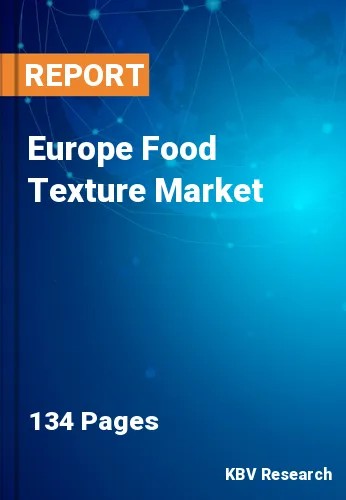The Europe Food Texture Market would witness market growth of 5.1% CAGR during the forecast period (2023-2030).
The market has been gradually growing because of the shift in consumer preferences, technological advancements, and the demand for processed and convenience foods. The market offers a variety of product categories, including texturizing chemicals, processing instruments, and products that alter texture. Food items with clean labels and natural ingredients have gained popularity. Customers are more conscious of the ingredients in their food and prefer products without artificial additives and preservatives. Natural texturizing components like pectin, agar, and guar gum have gained popularity in the market since they allow texture adjustment while meeting clean label rules.
Additionally, due to the rise in plant-based diets and the surge in demand for alternative protein sources, more attention is being made to developing plant-based and alternative food products. The texture is required to mimic the textures of their animal-based counterparts, such as meat and dairy products. As a result, food texture solutions that may simulate the appropriate textures in products manufactured from plants and other substitutes are becoming more prevalent.
With sales expanding at a CAGR of 1.6% during 2016–21 and total retail sales of US$21.1 billion, Italy ranked top in the EU’s market for baked goods in 2021. Sales are anticipated to grow more successfully between 2021 and 2026, with a CAGR of 4.4%, reaching US$26.3 billion by that year. The subsequent shift in German consumer behaviour has increased sales of baked goods since more people who work from home now eat breakfast at home, which raises the demand for bread. The number of Germans using supermarkets to buy bread is rising. Bread sales reached a CAGR of 1.0% from 2016 to 2021, reaching US$12.1 billion in 2021, and are expected to increase by 0.8% from 2021 to 2026 to reach US$12.7 billion. In Europe, the market is witnessing growth due to the growing demand for baked goods in the region.
The Germany market dominated the Europe Food Texture Market by Country in 2022 and would continue to be a dominant market till 2030; thereby, achieving a market value of $1,366.3 million by 2030. The UK market is exhibiting a CAGR of 4.2% during (2023 - 2030). Additionally, The France market would experience a CAGR of 5.9% during (2023 - 2030).
Based on Application, the market is segmented into Dairy Products & Ice Creams, Confectionery, Jams, Layers, Fillings, Bakery, Ready Meals, Beverage, Meat Products and Sauces & Others. Based on Product, the market is segmented into Natural and Synthetic. Based on Type, the market is segmented into Cellulose Derivatives, Gums, Inulin, Gelatins, Starch, Dextrins and Pectins & Others. Based on countries, the market is segmented into Germany, UK, France, Russia, Spain, Italy, and Rest of Europe.
Free Valuable Insights: The Worldwide Food Texture Market is Projected to reach USD 20.5 Billion by 2030, at a CAGR of 5.5%
The market research report covers the analysis of key stake holders of the market. Key companies profiled in the report include Koninklijke DSM N.V., Archer Daniels Midland Company, Desosen Biochemical (Ordos) Ltd., Ingredion Incorporated, Kerry Group PLC, Jungbunzlauer Suisse AG, CP Kelco, Cargill, Incorporated, DuPont de Nemours, Inc. and Euroduna Food Ingredients GmbH
By Application
By Product
By Type
By Country
Our team of dedicated experts can provide you with attractive expansion opportunities for your business.

